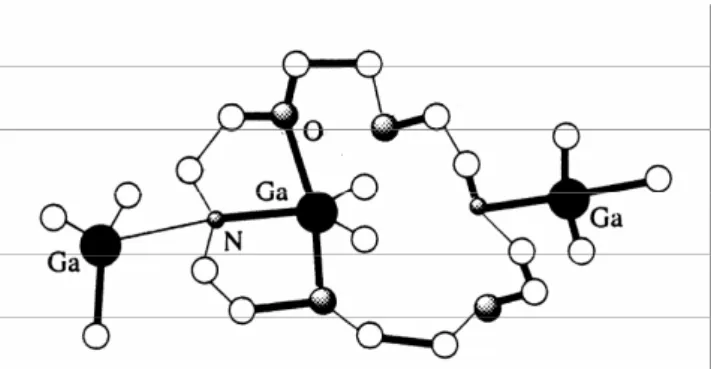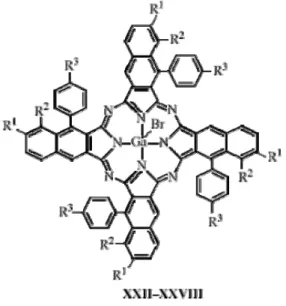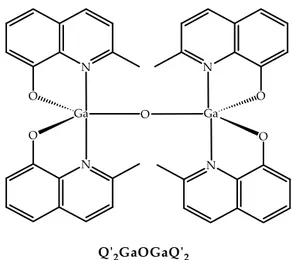_____________________________________________________________ 3
Chapter 1
Gallium
1.1 Introduction: General view on Gallium Gallium is a silvery blue and soft metallic element (Figure 1.1) that enjoys vast applications in optoelectronic (e.g., LED’s), telecommunication, aerospace, and many commercial and household items such as alloys, computers and DVD’s. Gallium represents a small annual tonnage of material, compared with aluminium or other metals, but it is important its impact as the backbone of the worldwide electronics sector. On the other side gallium compounds are attracting growing attention because of the interesting applications in medicine.The worldwide interest on gallium is quite recent respect to other elements and their applications, for instance if we take in account aluminium. So a primary observation is that literature and patent production on the chemical properties, synthesis and application of gallium, both inorganic and organic, compounds is enhanced in the latest years. Figure 1.1: gallium element.
_____________________________________________________________ 4 1.2 Gallium (the element) Mendeleev (Figure 1.2), studying the periodic properties of the elements knew at his time, had predicted the existence of a metal, called eka‐aluminium, located between aluminium and indium. Figure 1.2: Dmitri Mendeleev.
Gallium was discovered by the French chemist, Paul‐Emile Lecoq de Boisbaudran in 1875 (Figure 1.3) after the initial spectroscopic discovery then upon isolating the element as a free metal by electrolysis of a solution of gallium hydroxide in potassium hydroxide.1,2 Figure 1.3: Paul‐Emile Lecoq de Boisbaudran. The French researcher had first observed the principal spectral lines (Figure 1.4)
_____________________________________________________________ 5 Figure 1.4: spectrum of Gallium. while examining a substance separated from sphalerite (ZnS) (Figure 1.5). Figure 1.5: sphalerite.
Some individuals consider that the name gallium was derived from the Latin word for France, ‘‘Gallia’’. Another theory is that the discoverer perhaps used his own name (Lecoq) and took the Latin translation of a cock which is gallus. The soft and silvery blue metal gallium, symbol ‘‘Ga’’ within group 13, has an atomic weight of 69.723, a 1.5 Mohs hardness, and density of 5.904 and 6.905 g/cm3 for the solid and liquid phases respectively. A solid piece of gallium will
liquefy when placed in ones hand. The 31st element in Dmitri Mendeleev’s periodic table exhibits an unusually large liquid range of temperature of any element and/or metal due its melting point of 302.98 K and boiling point of 2676 K. Gallium has a low vapour pressure even at high temperatures. Solid gallium has an orthorhombic crystal structure and displays a conchoidal fracture similar to glass. Gallium can exist in the form of six isotopes of which only two are stable. This element normally has a valency of three with its compounds while the two stable isotopes are 69Ga (60.4%) and 71Ga (39.6%). Gallium can form
_____________________________________________________________
6
many substances such bromides, chlorides, hydrides, iodides, nitrides, oxides, selenides, sulphides and tellurides. The industrial usage of gallium began in the 1940s within the USA upon inception of recovery processes. The metal attracted more interest in the 1970s when it was discovered that gallium combined with elements of group 15 displayed semiconducting properties.
The chemical analysis of gallium used to manufacture semiconductors varies from six (6N) to eight nines (8N) purity (i.e., 99.999999%). Metallic gallium is magnetic and an excellent conductor of both heat and electricity.
Apart from caesium, mercury and rubidium, gallium is the only metal which can be in liquid form near room temperatures and hence is suited for high‐ temperature thermometers. Since gallium remains in the liquid state over a wide range of temperatures from about 30 – 2237 °C it is also suited as a lubricant for high‐temperature applications. Gallium is applied in alloys to substitute amalgams.3 Liquid gallium is used also as solvent for high temperature synthesis.4 Since the metal expands by 3.1% upon solidification, care must be taken with respect to the type of storage container. Solid gallium is less dense than liquid gallium showing the same characteristic of water which also expands when it freezes. Seeding may be required to initiate solidification since gallium tends to supercool below its freezing point. Consequently, special regulations must be applied when storing and transporting gallium by conventional carriers such as truck, rail and air. Both the physical and electrical properties of gallium are strongly anisotropic.
A thin oxide coating is characteristic of gallium material since it slowly oxidizes in moist air until formation of a protective film. Although the element is stable with water it reacts vigorously with halogens even at low temperatures. Metallic gallium slowly dissolves in dilute mineral acids and solutions of hydrogen halides in ether. High purity gallium is slowly attacked by mineral acids. The element rapidly dissolves either in aqua regia or concentrated
_____________________________________________________________ 7 sodium hydroxide in an aqueous medium. It also reacts with strong bases and oxidants.
Gallium forms a brilliant mirror when it is painted on glass and it wets both glass and porcelain. The element is suited to readily form alloys (i.e. some eutectic alloys: gallium indium and tin) with are used in dentistry in lieu of mercury. This alloy, with the trade name Galinstan, has a freezing point of −20 °C. Dental alloys containing 3% of gallium. A large quantity of gallium chloride (GaCl3) was provided during the construction of the Gallium Neutrino
Observatory in Italy to study atomic particles called neutrinos produced inside the sun during nuclear fusion. About 90 tonnes of gallium were used in the experiments to detect solar neutrinos as in the SAGE (Russian‐American Gallium Solar Neutrino Experiment) project.5,4
1.2.1 Occurrence and relative abundance
Gallium is considered one of the rarer elements in the Earth’s crust since its concentration is 16 parts per million (ppm). Trace amounts of gallium are recovered from bauxite (Figure 1.6), diaspore, germanite, sphalerite, pyrite and magnetite and in the by‐products of burning coal (lignite, brown and bituminous). Bauxite ores range in gallium content from 0.003% to 0.008% while Surinam bauxite is known to contain the largest amount at 0.008%.
_____________________________________________________________
8
The world supply of recoverable gallium hosted in bauxite are estimated in excess of 1 billion of kg. World zinc reserves are expected to also host a considerable quantity. Unfortunately, only a small percentage of gallium reporting in either bauxite or zinc deposits is economically recoverable. Although producers of virgin gallium operate in several countries, the major source of raw gallium stems from locations in Australia, the People’s Republic of China, Europe, Japan and Russia. France is the world’s largest producer of refined gallium upon processing crude gallium feedstock from Australia while Germany and Japan are also active as gallium refiners.
Traditionally, gallium is produced from processing reverts, scraps and impure metals. Gallium mineral is gallite (CuGaS2) (Figure 1.7) which occurs in Zaire
and other African areas. Apart from gallite, gallium does not form distinct minerals but substitutes for aluminium in the structure of many aluminium‐ bearing minerals. Zinc ores such as sphalerite (ZnS), which are a secondary source after bauxite, contain gallium.
Figure 1.7: two samples of gallite, CuGaS2
In order of priority, gallium is recovered from the industrial processes employed to produce aluminum, zinc, and to a lesser extent copper. It is worth emphasizing that gallium is not mined directly but is considered as a by‐ product in commercial operations. As a general rule, gallium is recovered as a by‐product during the manufacture of aluminium metal upon treatment of bauxite. The gallium fraction is extracted from the caustic liquor produced
_____________________________________________________________ 9 during the processing of bauxite to recover aluminium. Typically, 500 ppm of gallium report within bauxite deposits.
World primary production, in 2005, was estimated to be about 63 metric tons (or tonnes = 1000 Kg), about 5% higher than that in 2004. China, Germany, Japan, and Ukraine were the leading producers; countries with smaller output were Hungary, Russia, and Slovakia. Refined gallium production was estimated to be about 91 metric tons; this figure includes some scrap refining. France was the leading producer of refined gallium, using as feed material crude gallium produced in Germany. Japan and the United States were the other large gallium‐refining countries. Gallium was recycled from new scrap in Germany, Japan, the United Kingdom, and the United States. World primary gallium production capacity in 2005 was estimated to be 160 metric tons; refinery capacity, 140 tons; and recycling capacity, 68 tons. The world bauxite deposits are estimated to range from 55 to 75 billion tonnes then it is so large that much of it will not be mined for many decades thereby providing an assured source of supply. 1.2.2 Recovery methods for Gallium
Because of the low yield in processing gallium to fabricate optoelectronic devices or integrated circuits, substantial quantities of new scraps are generated during the various processing stages. These wastes have varying gallium and impurity contents, depending on the processing step from which they result. Gallium arsenide (GaAs)‐based scraps rather than metallic gallium represents the bulk of the scraps that is recycled.6
The most important source of gallium is Bayer‐process liquors produced during alumina production from bauxite ores.7‐9 For example, a concentrated Bayer process liquor can contain about 450 g/L of Na2O, 80 g/L of Al2O3 and 0.1970 g/L
_____________________________________________________________
10
of Ga. One of the largest potential resources is the waste stream from zinc production.
Gallium is contained as a minor compound at a trace level. Other alternative sources of gallium are from fly ash and from recycled scraps produced by the electronics industry. In the case of coal ashes, impurities such as Al, Fe and Ca are present in high amounts. As much as 26% Al2O3, 10% Fe2O3 and 4% CaO of
the total weight were reported. In comparison, gallium and zinc are at trace levels with amounts representing less than 0.013 wt% and 0.16 wt%, respectively.10‐12
The common processes to recover gallium include fractional precipitation,
electrolytic processes, chelating agents.
Upon treating the sodium aluminate solution containing the gallium impurity with CO2, aluminium hydroxide first precipitates out in the fractional
precipitation method thereby increasing the liquor’s gallium concentration. Continued treatment over several stages results in aluminium hydroxide richer in gallium. The enriched material is dissolved in aqueous NaOH. An electrolytic technique is applied to the resulting solution of sodium gallate and sodium aluminate. Apart from many precipitation stages, the process is labour intensive. The People’s Republic of China applies this method to produce 5 tpa (tons per annum) gallium in each state‐owned plant due to low labour costs and cheap electrical energy.
The second approach consists of an electrolytic process based upon either the Alusuisse or VAW/INGAL processes which rely on employing mercury to form an amalgam with gallium thereby allowing gallium extraction via caustic soda addition. Although environmental concerns associated with mercury discourage usage of electrolysis, the technique is in service in the Czech
_____________________________________________________________ 11 Republic, Germany and Hungary. Another disadvantage is the fact that very concentrated solutions in excess of 150 g/l sodium and with minimal impurities such as iron, molybdenum, tungsten and vanadium, are not produced in modern alumina plants. The third process is comprised of extracting gallium by means of chelating agents. Dilute acid is used to strip gallium and other elements from the extraction medium. Concentrated acid such as either HCl or H2SO4 is employed to extract the gallium fraction. Following ion exchange to
further concentrate the gallium, the element may be recovered via direct electrolysis. Purity is checked via residual resistivity ratio (RRR) while independent analyses are conducted using glow discharge mass spectrography.5 Many different companies are involved in gallium shortage easing then, researchers and patent are produced to find better gallium recovery methods from scrap, as secondary product of aluminium and zinc production or electronic industry wastewater.
The plutonium pits of nuclear weapons employ an alloy with gallium to stabilize the allotropes of plutonium. Gallium could be also recovered as waste of plutonium purification by nitric acid/TBP based solvent extraction.13
In the past few years, the application of extraction resins in metal extraction and separation processes has focused on hydrometallurgical and analytical applications, and in most cases related to rare metals applications in particular are tested to collect selectively gallium and indium in very good yield.14
Corresponding to the high price of GaAs wafers and other gallium based materials, the price of scrap and industrial or mining wastematerials is also very high. The recycled gallium price could achieve the same of the virgin gallium, if of the same purity. So the primary target is to find methods matching high purity gallium, low cost treatments and environmental safety in order to stabilize worldwide supply and demand for gallium.15
_____________________________________________________________
12
1.2.3 Gallium demand and production
Data on world production of primary gallium are unavailable easily because of data on the output of the few producers are considered to be proprietary. However, in 2004, world primary production was estimated to be about 69 metric tons, about the same as that in 2003. China, Germany, Japan, Kazakhstan, and Ukraine were the leading producers; countries with smaller output were Hungary, Russia, and Slovakia, 60 know producers are located in 18 different countries. The annual commodity trading of gallium worldwide historically approached 100 metric tonnes. However, the global primary production dropped from 75 to 61 metric tonnes in 2002. As an example of the disparity between suppliers and refiners, crude gallium production in 2001 was 81 tonnes while refined gallium amounted to 107 tonnes.
For instance U.S. Geological Survey (USGS) Mineral Commodity Summaries (MCS) include information on events, trends, and issues for each mineral commodity as well as discussions or tabular presentations on domestic industry structure, government programs, tariffs, 5‐year salient statistics, and world production and resources. The first few years of the new millennium saw a volatile gallium market. After a period of steady growth in the latter half of the 1990s, demand for gallium soared in 1999 and 2000. This was driven by booming demand for gallium arsenide‐based semiconductor
devices for mobile telephones as well as strong growth in sales of light‐emitting diodes for displays and for fibre optic data links. Worldwide gallium demand was forecast to grow at 6.5% py (per year) to reach 350t by 2008. However, 2001 saw a downturn in the electronics industry and gallium demand fell by one‐ third to 141t, causing major producers to withdraw from the industry and China to suspend production until demand recovers. Demand was expected to have recovered slightly in 2002 to 162t, but a return to the levels of 1999 and
_____________________________________________________________ 13 2000 was unlikely before 2004/05. With hindsight, it is clear that there was a spike in demand, though this was not as great as was reported. A real or perceived shortfall in supplies, combined with expected growth, led to high levels of purchasing and inventory build up.
It is probable that the underlying trend in worldwide gallium consumption has actually been a continuation of the steady 10% py growth seen through the 1980s and 1990s. Looking ahead, the rapid uptake of new technologies such as G3 mobile phone sets and white LEDs could return the gallium market to double‐digit growth, which could result in some short‐term supply shortages. In the 2006 edition, the USGS report that gallium prices rose slightly during 2005 at the beginning of the year, low‐grade gallium prices were reported to be about $300 per kilogram. By April, the price increased to $330 to $350 per kilogram and then increased to about $400 per kilogram in June.
For high‐purity gallium prices in the early 2006 were about $400 per kilogram, but increased to $617 per kilogram by midyear. Roskill Information Services (international corporation on metals and minerals in UK) forecasts that annual growth will average a more sustainable 8‐10% py to reach 280t by 2008 (Figure
1.8). It’s peculiar to note that the 7th edition of “The Economics of Gallium”
report is available at 3,725 US dollars cost.16, 6
_____________________________________________________________
14
1.2.4 Environmental, health and safety issues on Gallium applications
The board of directors of the World Bank Group reviewed policies related to loans, and it expressed the belief there is a continuing role for the World Bank Group in supporting the extractive industries, provided it supports poverty reduction and sustainable development.
When the geographic broadening of mineral exploration began in the 1980s, many developing countries lacked environmental regulations, and their populations were largely uninvolved in environmental issues. In Indonesia, closure of the Minahasa gold mine has been accompanied by a dispute between the Government and Newmont Company over alleged mercury and arsenic contamination in Buyat Bay. In Peru, public response to environmental issues has been mixed. In April (2004), residents of the city of La Oroya threatened to march on Lima to protest the Government’s refusal to allow The Doe Run Company to extend a deadline for environmental compliance. In September, public protests disrupted operations at Newmont’s Yanacocha gold mine contending exploration was affecting the quantity and quality of local water. The Brundtland Commission of the 1980s defined the concept of sustainable development as “meeting the needs of the present, without compromising the ability
of future generations to meet their own needs”. The World Business Council for
Sustainable Development has defined it as “ensuring a better quality of life for
everyone, for now and for generations to come.” It combines economic, social and
environmental concerns, (often called the triple bottom line) and offers business opportunities for companies that can improve the lives of the world’s population.17 “Science and technology have a key role in ensuring the sustainable
development of the global community”.18 The environmental impact of the new materials research and the high technologies have attracted much attention in the latest year. So the government and the public institutions legislations push
_____________________________________________________________ 15 the universities, the private companies and consumers to assume regulations to treat with care, as hazardous, any chemical or manufactures to avoid their release into the environment.19 Although the toxicity of gallium apparently is of a low order, the element should be handled with care until further data becomes available. The metallic substance may cause skin and eye irritation while some suggest that gallium may cause dermatitis. It is surprising that gallium is used as a replacement for mercury in dental amalgams.5 Consequently, good industrial hygiene is recommended for airborne particulates. The work place exposure limit (WEL) is defined as “the airborne
concentration of a chemical to which nearly all workers may be repeatedly exposed day after day, without any adverse effect” defined by OSHA (Occupational Safety and
Health Administration) and ACGIH (American Conference of Governmental Industrial Hygienists), for instance the WEL for gallium oxide is 0.005 mg/m3,
the maximum level of exposure to chemicals as air contaminants that may be allowed during 8‐h day and 40‐h week without adverse health effects.20 Optoelectronic manufacturing is a metallic‐intensive modern industry where workers are potentially exposed to toxic metal of IIA, IIIA, VA, and VIB families, including aluminium (Al), gallium (Ga), indium (In), arsenic (As), antimony (Sb), zinc (Zn) and selenium (Se). These metals were known to alter several cellular functions, resulting in eukaryotic cell death and carcinogenesis in animals in clinic studies.21 The studies on the exposure of the optoelectronic industry workers to aluminium (Al), gallium (Ga), indium (In), arsenic (As), antimony (Sb), show elevated blood In, urine Ga and As levels.
The protective equipments and the education training on safety play an important role when exposure operation occurred. The cited heavy metals accumulate in the optoelectronic worker’s body mass at list 22% more than non exposed people’s body.22, 23 Different kind of studies show the clear evidence of the carcinogenicity of gallium inorganic compounds. Gallium it present in
_____________________________________________________________
16
human tissues at a level of only 10‐4 to 10‐3 ppm.24 Because of the threshold limit values of blood and urine gallium human levels are not well known, more work will be needed to clarify the relationship of metals exposure and health effects.25 Industrial spills can lead to high concentrations of toxic materials in rivers, affecting freshwater ecosystems with acute and chronic toxicity so the research target is to investigate new strategies with the proposal for the development of chemistry of an industrial environmentally friendly process.26,27 In general gallium can interfere with calcium uptake; the element is a potent inhibitor of protein and DNA synthesis, could cause bone marrow depression, testicular toxicity and hemorrhagic nephritis in mammals. Many countries have to monitoring the heavy metal impact, but individual metals pose different problems into the environment and therefore they have to be considered separately. For instance to better understand the gallium impact on freshwater systems, the sublethal gallium concentrations on biomedical and morphology parameters of the common carp (Cyprinus carpio) were investigated. Because of the common carp is an important cultured species near semiconductor manufacturing districts in Taiwan, the study demonstrate the correlation between the high concentration level and the toxicity displayed by the progressive erythrocyte membrane deformation. The biologically safe level proposed for this kind of fishes is 2.0 mg/L, in that case gallium reveals less toxic effect than zinc in the same conditions.28,29 Gallium has two naturally occurring isotopes (69Ga, 60.5%; 71Ga, 39.5%) and 13 radioactive nuclides. 67Ga
and 68Ga are two radioisotopes with appropriate energies and half‐lives
respectively (67Ga, γ, t1/2 = 78 h; 68Ga, β+, t1/2= 68 min) for γ‐scintigraphy and
positron emission tomography (PET), their complexes once in the organism, the metal is delivered by the biotransporter transferrin. These radioisotopes are administered to the patient in the form of stable chelates. Although gallium is not considered as essential to life, their trivalent ions are, nonetheless, of great
_____________________________________________________________ 17 interest. Gallium was the second metal, after Platinum, to be used in cancer treatment, its anticancer properties were described for the first time in 1971.30,31 Gallium is also applicable in antitumor trials to detect and localize malignant tumor cells associated with hypercalcemia. Clinical trials of gallium nitrate exhibit favorable therapeutic efficacy in lymphoproliferative disorders and urothelial tract tumors. A number of studies are focussed on the anticancer activities of GaL3 complexes with HL is trisbidentate ligand.32‐35 The
organometallic gallium compounds also are under investigation due to their ability to penetrate the cell membranes, moreover these complexes show interesting antimalaric properties.36
1.3 Gallium chemistry issues
The current considerable investigation on organogallium and on gallium coordination compounds is due to the their rich structural chemistry that may be applied in different field as in the genesis and diagnosis of disease, in ceramics or as emitting and/or customized multifunctional materials. The largest molecular structure as atom–centred neutral metal cluster is the gallium material Ga22{Si(SiMe3)3}8. The structure is unique in having a central gallium
with a coordination number of 13. This shell of 13 gallium atoms has very similar coordination to cuboctahedral geometry (Figure 1.9).37
Figure 1.9: [Ga22{Si(SiMe3) 3}8] structure: a) Ga⋅Ga13 central core is rounded by eight GaSi(SiMe3)3 groups, the 24 SiMe3 were omitted for clarity ; b) Ga⋅Ga13 central core.
_____________________________________________________________
18
The historical development of the organometallic chemistry of gallium start in 1932 when the triethylgallium Et3Ga was described by Dennis and Patnode,38
the story of this first organogallium compounds synthesis was unusual intriguing as a detective story.1 For decades following their discovery, organogallium compounds gardened limited attention and were largely considered little more than laboratory curiosities. Indeed, Pauling once opined that the chemistry of gallium was limited and of little practical importance.39 The gallium(I) halide with general formula MX(L)n (X= halide; L= ether; amine,
phosphane or silane) complexes is a metastable compound exploited to form polyhedral metalloid clusters. The basic step is obtain gallium(II) iodide adduct that probably involve partial disproportionation of the GaI reagent upon treatment with Lewis bases.40 The structure proposed for GaI is [Ga2][Ga2I6] based on Raman spectroscopy studies, it is obtained by sonication of metallic gallium with 0.5 equivalent of I2 in toluene at 50°C.41
The first organometallic compound containing the Ga—Ga bond, reported in 1979,42 introduce the novel concept of “gallium(II) dihalides” with the synthesis of four‐coordinate gallium atoms in the molecular structure, Ga2Cl4(dioxane)2.
This aspect of gallium chemistry was recently investigated, one example is the mixed‐valent compound Ga3I5∙3PEt3 containing Ga—Ga—Ga likage (Figure
1.10), were the Ga(I) center is the brindging moiety for two Ga(II) units
coordinated with two phosphorous atoms.43
_____________________________________________________________ 19 The possibility to obtain compounds with a perfectly planar gallium thee‐ membered ring is another aspect of the organogallium chemistry. The studies of the Na2[(Me3C6H2)2C6H3Ga]3 structure (Figure 1.11), support the existence of an
aromatic behaviour. The gallium atoms are taken to be sp2 hybridized along
with one the unhybrized p orbital on each gallium atom. Moreover, the three p orbitals are populated by two electrons, one from each of the sodium atoms. Thus, this first example of a gallium ring compound, a cyclogallene is also a 2π aromatic system.1
Figure 1.11: Na2[(Me3C6H2)2C6H3Ga].
In the case of Na2[{(Pri3CH6H2)2C6H3}Ga≡Ga{C6H3(Pri3CH6H2)2} (Pri= m‐
terphenyl) complex, the omonuclear diatomic triple bond was firstly observed. The existence and the nature of the Ga≡Ga bond is disputed to demonstrate if the digallium compound represent an acetylene‐like, or gallyne, bond.44‐47
Currently, trimethylgallium (TMG) is used as group III source in MOVPE (Metal Organic Vapour Phase Epitaxy) technique, in combination with AsH3
and PH3 as group V sources, to grow the III‐V semiconductor layers of GaAs
and InP used in optoelectronic devices. But trimethylgallium is pyrophosporic and extremely sensitive to oxygen and moisture because of their coordinative
_____________________________________________________________
20
insaturation. In order to work with air‐stable precursors, intramolecular coordination to five‐ six membered ring is promoted.48‐50
Gallium hydride is obtained by methatesis of GaCl3 in ethers in the reaction
illustrated in Scheme 1.1.
4 LiH + GaCl3 LiGaH4 + 3 LiCl
Scheme 1.1: gallium hydride formation.
Gallium hydride derivatives could be precursors of gallium trialkyls in chemical vapour deposition applications. Stable gallium hydride derivatives containing bulky ligands are promising because of the lower conversion temperatures and reduced carbon contamination.51,52
1.3.1 Gallium(III) coordination compounds
The most stable oxidation state is 3+ which renders Ga3+ strongly acidic.
Therefore gallium(III) coordinate electron‐rich neutral or anionic donors, mainly O, S, and N donors. Gallium ion display coordination number from 3 to 6 depending on the size, shape and denticity of the ligand moiety. Gallium(III) compounds obtained with different kind of mono‐ and multidentate ligands suchlike halogens, hydrides, eteroatomic groups, heterocyclics and so on are well known.53
In details the attention is focussed on gallium(III) complexes with multidentate ligands (linear, branched or cyclics) because of the marked tendency of the coordination number to increase from four to five or six.
Furthermore when multidentate ligands are used, more species may be obtained. The structure of these depend on the nature of the ligand and include monomeric species, dimeric derivatives containing five‐coordinate metals
_____________________________________________________________ 21 centres, and more complex molecules containing metals in different coordination environments in the same molecule. The type of the complex formed is dependent on several variables, including the size and the structure of the bidentate or polydentate ligands.54–56 With potentiometric measurements, Harris and Martell found the equilibrium constants of the gallium(III) reactions in aqueous solutions with multidentate ligand, containing a combination of different kind of reactive sites: phosphonates, acetates, phenolates, tertiary amino donor groups, carboxylates. Some of these ligands strongly bind gallium(III) and it was observed that, even at lowest measurable pH, gallium(III) ions are 100% complexed. It occur when the ligand is characterized by an high stability constant, so the presence of the free Ga(III) is regulated at low concentration and the precipitation of Ga(OH)3 is avoided, in accordance
with the solubility product (Ksp = [Ga3+][OH‐]3 = 1.00 x 10‐37). As the pH increase,
virtually every multidentate ligand dissociates from gallium because of the strong tendency of the Ga(III) to undergo hydrolisys to form the soluble Ga(OH)4‐ (Scheme 1.1), so the multidentate ligand is displaced from the gallium
coordination sphere and is replaced by four hydroxide ions.57‐59
GaL(3‐n) + 4 OH‐ Ga(OH)4‐ + Ln‐
Scheme 1.2: gallium(III) hydrolisys reaction.
These studies suggest that the synthesis of the gallium(III) complexes may be modulate under pH control in aqueous solutions.
The chemistry of frameworks, combining rigid an flexible organic structures, permit to bind two or more metal, Lewis acid centres, by reacting alkylgallium compounds, gallium halide or gallium salts as Ga(ClO4)3 or Ga(NO3)3 with a
several numbers of insature end/or aromatic O,O; O,P; O,N; N,N donor ligands.60‐64
_____________________________________________________________
22
High binding constants for these Ga3+ ions are generally found with
multidentate Lewis base ligands, and in particular the phenolate anion is a strongly coordinating moiety. The complex stability is due the cooperative effect of the organic ligand.
1.3.2 Neutral hexacoordinated Gallium compounds: heteroleptic and homoleptic complexes
In general, group 13 heteroleptic compounds, that incorporate different ligands, may undergo methatetical and/or redistribution reaction to form equilibrium mixtures with multiple symmetrized species. Consequently, chemical stable, fully characterized, pure monomeric compounds with two and three different ligands are unusual.65
The literature report 16‐membered macrocyclic tetramers, obtained from trialkyl gallium compounds and bifunctional Schiff bases, contains both tetracoordinated and hexacoordinated metal centres.66
In other case heteroleptic‐like hexacoordination may be considered in bimetallic complexes where each gallium centre “see” mixed ligands in own coordination sphere.67 In general starting from bidentate to tri‐ or hexadentate ligands an higher thermostability is expected such as macrocycle‐based or flexible ligands. Octahedral coordination is obtained when the reactive sites are located on a macrocyclic or big flexible ligand, in that case only one ligand is responsible of the hexacoordination. The uninegative bidentate O,O ligands, as β‐diketonate [OC(R)CHOC(R)]‐, or involved in the reactions, enhances the stability of the
Gallium(III) complexes in which is incorporated. Thus reduce the compound tendency to undergo redistribution reaction. So hexacoordinated, better ordered system with octahedral symmetry, is promoted to form Ga(acac)3 compounds.68
_____________________________________________________________ 23 A dissociative mechanism proceeds via a five‐coordinate transition state in which one ligand is unidentate. The bond strength decrease in the order Al—O > Ga—O > In—O.
Hexacoordinated gallium compounds were also obtained with three equivalent of hydroxamate functional group (R(OH)NC(O)R’) to study their stability and chirality to be exploited in biology. In other cases the O,O ligand could be 3‐ hydroxy‐4‐pyridinone ligands bearing pendant biological derivatives or curcumin derivatives. Neutral homoleptic trischelated complexes predominate from pH 4.5 to 9.69, 70 These kind of ligands are suitable to design and synthesis functional materials via self‐assembly of molecular components in a “bottom‐ up” strategic approach, useful in nanotechnology. In particular the literature recently report the synthesis of new gallium(III) structure capable of host‐guest chemical interactions (Figure 1.12). Figure 1.12: on the left representation of M4L4 tetrahedron, on the right representation of the addition of the mononuclear metal complex methylene. The rigid 3‐fold symmetric ligand on the left forms an M4L4 tetrahedron, while
the addition of methylene bridges to the ligand on the right adds sufficient flexibility to favor the formation of the mononuclear metal complex as the lowest stoichiometry product. The cavity shape of the M4L4 cluster can be best
approximated as a tetrahedron. The large tetrahedron coordination cage is obtained combining four pseudo‐octahedral metal centres (tetrahedron vertices,
_____________________________________________________________ 24 Figure 1.13) with four 3‐fold symmetric, tris‐bidentate O,O ligands that cap the faces of the tetrahedron in a M4L4 “face‐on” design.71 Figure 1.13: Here are views down the vertex (left) and a face (right) showing an inscribed tetrahedron in the host cavity.
Gallium(III) complexes obtained with O,N ligands, Schiff‐bases, EDTA derivatives, aminoacids, iminophenolate, are under investigation due to their rich structural chemistry and possible applications. This class of neutral hexacoordinated O,N gallium complexes is constituted by a wide range of homoleptic gallium(III) quinolinate derivatives.72
1.3.2.1 8‐hydroxyquinolinate gallium(III) compounds
8‐hydroxyquinoline (HQ) (Figure 1.14) and it derivatives are well known O,N bidentate ligands able to bind a large number of metal cations. These organic molecules have long been extensively used in analytical chemistry to purify selectively cations mixtures. N O 8‐hydroxyquinoline N OH HQ = Figure 1.14: 8‐hydroxyquinoline.
_____________________________________________________________ 25 HQ is soluble in most of organic media and its neutral chelates are stable compounds that can be solubilized in chlorinated solvent. These properties makes 8‐hydroxyquinoline and many of its substituted derivatives strong chelating agent for metal extraction.73 ‐ 75
Gallium(III) compounds GaQ3 and GaQ’3, respectively obtained with three
equivalent of 8‐hydroxyquinoline (HQ) or 2‐methyl‐8‐hydroxyquinoline (HQ’) are neutral homoleptic hexacoordinated complexes approximating octahedral geometry. In the latest years the solid state structure of GaQ3 and GaQ’3,
illustrated in Figure 1.15, were studied to explain the optoelectronic property of these materials.
Figure 1.15: molecular structure of GaQ3 on the left and GaQ’3 on the right.
When HQ and HQ’ react with gallium(III), two geometric isomers of GaQ3 and
GaQ’3 could be obtained. The meridional (mer‐) with C1 symmetry and facial
(fac‐) with C3v symmetry show the quinolinate moieties respectively in cis and
trans conformation as reported in Figure 1.16, each isomer leads to a further two Δ and Λ optical isomers .
_____________________________________________________________ 26 Figure 1.16: conformational isomers of homoleptic gallium(III) quinolinate.
However, we could only observe the trans isomer in the crystal, thermodynamically more stable. 76–78 The electro‐optical features of these
material are under investigation taking in account the solid state properties. Recently the chemical structure of a series of methyl (Me) substituted group III metal tris(8‐hydroxyquinolinolate) chelates (nMeQ3M: n= 0, 3, 4, 5; M= Al3+,
Ga3+), was related to their photoluminescence (PL), electroluminescence (EL),
and thermal properties.79 The research is oriented to enhance the solubility properties of hexacoordinated quinolinate gallium compounds to improve their technical applications.80 Dimeric complex of hexacoordinated gallium as bis(salicylidene‐o‐aminophenolato)‐bis‐(8‐quinolinolato)‐bis‐gallium(III)
[Ga2(saph)2q2], illustrated in Figure 1.17, is a rare example of structure bearing
only one moiety of 8‐hydroxyquinoline further its show interesting electro‐ optical properties studied in device fabrication.67 Figure 1.17: [Ga2(saph)2q2]. N O O N O facial meridional M N cis‐isomer trans‐isomer N O O O N M N
_____________________________________________________________ 27
1.3.3 Pentacoordinated Gallium complexes
Five coordinate complexes of Group 13 metals are still not very common. Stable pentacoordinated gallium complexes have been synthesized and characterized crystallographically where the geometries have been stabilized by either deployment of bulky ligands (Figure 1.18), or by using macrocyclic Iigands. Introduction of alkyl groups has also been found useful in stabilizing these structures by reducing Lewis acidity at the metal centre.81
Figure 1.18: Molecular structure of GaCI[PhC(S)CHC(O)Ph]2
Generally gallium pentacoordinated compounds were synthesised using different ligand in particular most of the organogallium compounds were obtained with alkyl ligands.82,83
Neutral pentacoordinated gallium(III) complexes are unusual. Some example bear O,N or S or P reactive sites on ligands side arms that improve the stability of the pentacoordinated metal centre. These variations of the sidearm donor atoms have the potential to enable rational modifications that can be tuned to stabilize desired structural characteristics such as bis‐chelates.84 – 87
The first crown ether structure as pentacoordinated gallium(III) compound reported in literature was (Me2Ga)(C12H25N2O4)(GaMe3)2, illustrated in Figure
1.19, where the inner gallium centre is pentacoordinated showing distorted
trigonal bipyramid.88, 89
_____________________________________________________________
28
Figura 1.19: crown ether gallium compound (Me2Ga)(C12H25N2O4)(GaMe3)2
The class of gallium pentacoordinated compounds is growing rich by corroles, porphyrins and phthalocyanines gallium complexes (Figure 1.20) for the preparation of novel organic or polymeric compounds of interest in the search of new materials with excellent photophysical, optoelectronic and conductive properties as well as biological activities.
Figure 1.20: example of Ga(III) corrole.
The cavity of the heteroaromatic macrocyclic centre can host a metal cation. Generally gallium is tetracoordinated into the ligand central cavity and the pentacoordination is achieved by a monodentate ligand in the axial position,
Figure 1.21 illustrate an example of substituted phtalocianine with gallium
atom in the central core. So different interesting structure were obtained.90 – 93
_____________________________________________________________ 29
Figure 1.21: example of gallium phtalocianine.
These kind of compounds exhibit strong absorption in the near IR range and have already found applications in photoconducting materials for information recording and in optical recording devices using semiconductor lasers.94
Pentacoordinated gallium(III) compounds, synthesised with two identical O,N bischelated ligands and a thirth monodentare ligand, are uncommon.
Recently the synthesis of pentacoordinated gallium(III) compound obtained with 4‐hydroxyacridine/Ga(III) salts, 2:1 molar ratio was described. The pentacoordination is achieved with an halide, nitro group or a phenol monodentate ligand. These compounds display photophysical properties.95 Gallium shows high affinity with Salen ligands to form a wide range of examples of pentacoordinated compounds.96
Gallium(III) salts reacting with 2‐methyl‐8‐hydroxyquinoline (HQ’), HQ’/Ga(III) 2:1 molar ratio, and with mono‐ or bidentate ligand LH give pentacoordinated compounds with general formula Q’2GaL. As reported in
_____________________________________________________________
30
so pentacoordinated compounds with the general formula Q’2GaL were
obtained. 97, 98 These compounds shows trigonal bipyramid geometry and the monodentate ligand is an halide and/or an HL, monodentate or bidentate carboxylic acid (Figure 1.22), including the oxo‐bridged Q’2GaOGaQ’2,
illustrated in Figure 1.23.99 F, Cl O A c = O Piv = O CH3 O CF3 O O C(C H3)3 O O CN O O O O O N O Ga N O = O CF3 = O CN = O CO P = Q ʹ2G aL O N O N O Ga N O N O Ga HO OH O O HO OH O O HO OH O O = Figure 1.22: monometallic and bimetallic pentacoordinated compounds.
_____________________________________________________________ 31 Qʹ2GaOGaQʹ2 N O Ga O N O N O Ga N O Figure 1.23: bimetallic gallium compounds Carboxylic and phenoxide ligands show high affinity towards gallium and the steric hindrance of the methyl group in the second position near the nitrogen site prevent the stable hexacoordinate GaQ’3 formation.100,101 These compounds
exhibit luminescent properties. Crystallographic analysis on the Q’2GaOAc
(Figure 1.24) or Q’2GaOCl compounds show almost regular trigonal bipyramid
geometry. The average Ga—O bond length is 1.875 Å shorter than Ga—O bond in either GaQ3 and GaQ’3, while the average Ga—N bond length, about 2.096 Å,
is close to the value reported for GaQ3. The crystal lattice show a π‐π stacking
of 3.38‐3.45 Å.
Figura 1.24: Q’2GaOAc.
These observations suggest that the absence of one HQ’ unit give the pentacoordinated compounds more stable than GaQ’3, further an extented π‐π
_____________________________________________________________
32
their promising electro‐optical properties. The behaviour as electroluminescent or charge transport materials have been tested as organic thin solid film in multilayer OLEDs (Organic Light Emitting Devices) structures.
1.4 Charged Gallium compounds.
If gallium thrichloride react with an excess of Li reagent an alkylgallium salt can be obtained as shown in Scheme 1.3. Li4(C2H5)4 + GaCl3 LiCl + Li[Ga(C2H5)4] Scheme 1.3: Li[Ga(C2H5)4] alkylgallium salt.
The protolys of GaR2 groups being cleavage resistant allow the possibility to
have charged organogallium species in solution of the type illustrated in Figure 1.25. Ga CH3 H3C H2N NH2 + Figure 1.25: charged organogallium example
The first gallium cation, [Me2Ga(NH)2]Cl, was prepared in 1933, although it was
not accurately described as a cation until 1962. New cationic derivatives can be prepared by metathesizing the chloride of [Me2Ga(NH)2]+Cl‐ with NaBH4 and
by replacing the NH3 groups with an ethylenediamine ligand (en).
This example show that cationic compounds are well‐known to undergo redistribution reactions, so the formation of different cations can be obtained by
_____________________________________________________________ 33 exchange of ligands and or an halide. Most of the transformations conducted with neutral group 13 derivatives could also be accomplished with those that are cationic.104,105
Historically viewed as scientific curiosities, group 13 cations are now receiving increasing attention due to their potential as Lewis acid catalysts. Cationic complexes are interesting for many of catalytic applications because of the increased electrophilicity resulting from the cationic charge may enhance substrate coordination and activation.
Cationic gallium species with chelating ligands are desirable for application in homogeneus catalytic reactions such as alkene polymerization to prevent indesirable ligand exchange/redistribution reactions. As such they have already found applications in isobutene, ethylene, alkene oxide, and D,L‐lactide polymerization catalysis. The target is to synthesis gallium cationic compounds which are expected more stable than the aluminum cationic compounds. 106 The chemistry of charged gallium compounds involve a wide range of organic ligands with different O, N donor or negative P atoms.
Example of gallium complexes trischelate comprising symmetric and asymmetric imidodichalcogenodiphosphinate backbones are synthesised, but there are only a few examples of mono‐chelate salt‐like complex as [Ga{N(SPiPr2)(SePiPr2)‐S,Se}2] [GaCl4] bearing such types of ligands, and even
less with asymmetric ligands (Figure 1.26).107 Ga S Se Se S P P P P N N Pri Pri Pri Pri Pri Pri PriPri + GaCl4‐
Figure 1.26: [Ga{N(SPiPr2)(SePiPr2)‐S,Se}2]+ [GaCl4]‐ compound.
_____________________________________________________________
34
Charged gallium compounds can be salts containing both anionic and cationic gallium centers. The LiBZN (BZN = 2‐(dimethylaminoethyl)phenyl) reacting
with GaCl3 affords the formation of tetracoordinated [BzN2Ga][GaCl4]
compound (Figure 1.27).108
Figure 1.27: [BzN2Ga][GaCl4] compound.
The ethylenediamine unit represents an ideal fragment with which to construct a multidentate ligands. The diamino moiety allows functionalization to incorporate other donor atoms, and the close proximity of the donor atoms maximizes the number of five‐ and six‐membered chelate rings. Ga3+ show
strong chemical affinity towards many multidentate ligands to affords stable complexes.
These compounds can be useful in nuclear medicine, they must be kinetically and/or thermodynamically stable with respect to hydrolysis and demetalation by the serum protein transferrin.109, 110
Further multidentate ligands capable to conveniently chelate gallium(III) are under investigation to explore alternative scaffolds as potential targeted anticancer metallopharmaceuticals.
The challenge is to obtain biologically lipophilic monocationic characteristics for conferring intracellular targeting as potential cytotoxic agents. Schiff‐base
_____________________________________________________________ 35 hexadentate ligands, with the general structure N4O2 as illustrated in Figure
1.28, offer flexibility since their binding affinities can be varied by inserting
appropriate donor atoms N N N H NH O‐ O‐ R1 R2 R3 R4 R2 R1 R3 R4 Figure 1.28: N4O2 Schiff‐base.
Further studies are needed to evaluate the cytotoxic action mechanism of cationic gallium compounds related to the chemical structure functions.111
Plasmodium Falciparum, responsible of the malaria propagation, is increasing the
resistance to chloroquine‐based antimalarial drugs.
New drugs capable of overcoming the cytotoxic resistance of the parasitic are under investigation.
In order to improve the access and distribution of drugs in underdeveloped regions of the world it is necessary to synthesis alternative drugs from commercially available, inexpensive precursors, via short synthetic routes. For that reasons Schiff‐base amine‐phenol ligands can be economically favourable. Further this kind of ligands, capable of generating stable gallium(III) complexes, possess favorable balance of hydrophobicity and delocalized cationic charge conferring enhanced membrane permeability.The activity of gallium(III) compounds obtained with amine phenol ligands as [Ga‐ 5‐Madd], [{1,12‐bis(2‐hydroxy‐5‐methoxybenzyl)‐1,5,8,12‐tetra‐azadodecane}‐ gallium(III)] (Figure 1.29) have shown efficacy in vitro as antimalarials.112
_____________________________________________________________ 36 Figure 1.29: [Ga‐ 5‐Madd] [PF6 ] The combination of imino and phenolic groups in a rigid macrocyclic structure is an other key to synthesis mono‐ or heteronuclear complexes as well as porphyrins as described in Figure 1.30.113
Figure 1.30: M= Ga, A‐= [(CF3)2C6H3]4B‐
Metalloporphyrins can be lipophilic chemical structures that exhibit unique anion ionophore properties when incorporated into plasticized polymer membranes. One objective is to employ these host compounds to prepare either electrochemical or optical sensors that provide analytically useful anion responses, so polymeric membranes/films doped with different kind of host
_____________________________________________________________ 37 materials exhibit anions selectivity. Charged bimetallic gallium porphyrins are under investigation as potential anion sensors.114 Growing interest towards charged gallium complexes is also due their structural properties promising building block to design new materials. Helicates or meso‐helicates are metallo‐ supramolecular coordination compounds, which are formed in self‐assembly processes from two or three linear oligo‐donor ligands and two or more metal ions. The highly alkyl‐substituted ethylene‐bridged bis(8‐hydroxyquinoline) ligand derivative, 9‐H2, can give the formation of neutral supramolecular
gallium(III) complexes. But in the presence of MCl (M= Na, K, NH4) the
cryptates [M{(9)3Ga2}]+ are obtained in a template‐directed self‐ assembly
process as reported in the Scheme 1.4.
Scheme 1.4: formation of gallium(III) complexes from 9‐H2.
In this process three organic building‐blocks are brought together by coordination to the metal ions to form one “cylindrical” supramolecular aggregate which can eventually bind small molecules or ions in its interior. Due to the high charge of the helicates their chemistry is restricted to polar solvents but in the case of the compound showed in the Scheme 1.4 an enhanced
_____________________________________________________________
38
solubility in apolar solvent is observed. So the enhanced solubility in apolar solvents make these compounds available for host/guest chemistry, therefore they are potential candidates for phase transfer catalysis or for the preparation of dendrimer‐type complexes.115‐117
The reaction of GaX3 (X= Cl, Br) with bidentate amine such as ethylenediamine
(en), 1,10‐phenantroline (phen) or 2,2’‐bipyridine (bipy), should favour formation of five‐ coordinated gallium(III) compounds. The observed gallium product are six‐ coordinate complexes formed by partial or complete displacement of the halide from the coordination sphere [GaCl2(phen)2]Cl or
[Ga(phen)3]Br3 or by introduction of a solvent molecule in the coordination
sphere. Ethylenediamine complexes of dimethylgallium chloride are four‐ coordinate [GaMe2(en)2]Cl. In the case of 2,2’‐bipyridyne sigle crystal X‐Ray
diffraction reveals the ionic adduct cis‐ [GaCl2(bipy)2][GaCl4].
These observations would suggest that five‐coordinate gallium(III) is kinetically labile and thermodynamically unstable relative to the four‐ six‐ coordinate states, so monomeric five‐ coordinate gallium(III) complexes obtained with N,N bidentate amine are rare examples.118,119
It is 117 years since Blau first reported the synthesis of 2,2’‐bipyridine (bipy) and described the first metal complexes of this important ligand. Since then bipy and its derivatives have been continuously and extensively used in several aspects of coordination chemistry. Despite the great progress in the synthesis and physical studies of complexes of the d‐ and f‐block metals with bipy and its derivatives, the number of Ga(III) (and generally of the Group 13 metal ions) complexes with these ligands is still limited. For example, only recently the first structurally authenticated, homoleptic Ga(III)‐bipy complex, [Ga(bipy)3]I3, was
reported,120 while Ga(III)‐dimethylbipyridine complexes as are totally unknown in the literature.121 Figure 1.31 illustrate [GaCl2(dmbipy)2][GaCl4] and [Ga(H2O)2(dmbipy)2](NO3)3.
_____________________________________________________________ 39
Figura 1.31: [GaCl2(dmbipy)2][GaCl4] and [Ga(H2O)2(dmbipy)2](NO3)3 .
Generally N,N bifunctional ligands as ethylenediamine (en), rarely bind gallium as bidentate ligand in most of cases stable bimetallic neutral compounds are obtained were each gallium atom is coordinated by one nitrogen, the possible stoichiometry of the gallium amine adduct can be 1:1 or 2:1 Ga/en molar ratio. 122 ‐ 124
Cationic gallium compounds are under investigation for their promising anticancer activities, so recently gallium charged compounds were synthesises using asymmetric NN’O tridentate ligand as reported in Scheme 1.5.
_____________________________________________________________
40
Sheme 1.5: gallium complexes obtained with asymmetric tridentate NN’O ligands.
The therapeutic activity of gallium(III) complexes, was tested as potent antineuroblastoma drugs. Phenolate groups are used in the ligand design for the presence of a range of ring substituents and to limit the need for counterions in charge balance. Additionally, these organic species can be synthetically modified to enhance their water solubility by attaching groups to the amine nitrogen.
It is noteworthy that the complexes showing stronger antineuroblastoma activity are those containing electron‐withdrawing groups, such as halogen substituents, or to a lesser extent, nitro substituents on the phenolate rings. The position of the substituents on the ring can be of some relevance. It is not clear what role is played by the geometry of these complexes, although the lower symmetry seen for 3 (local Ci) when compared to 1 (local D2h) (Figure 1.32) may be associated with their activity.125
Figure 1.32: [Ga(III)L(MeO)2] ClO4, R= H, R’=methoxy group.
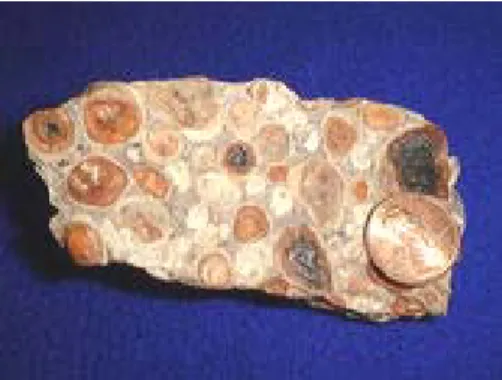
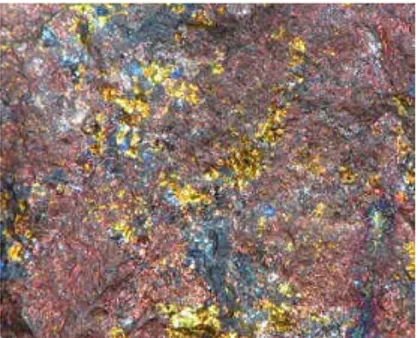
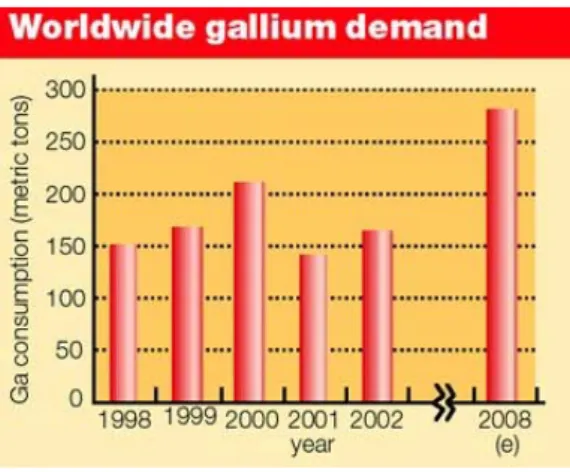
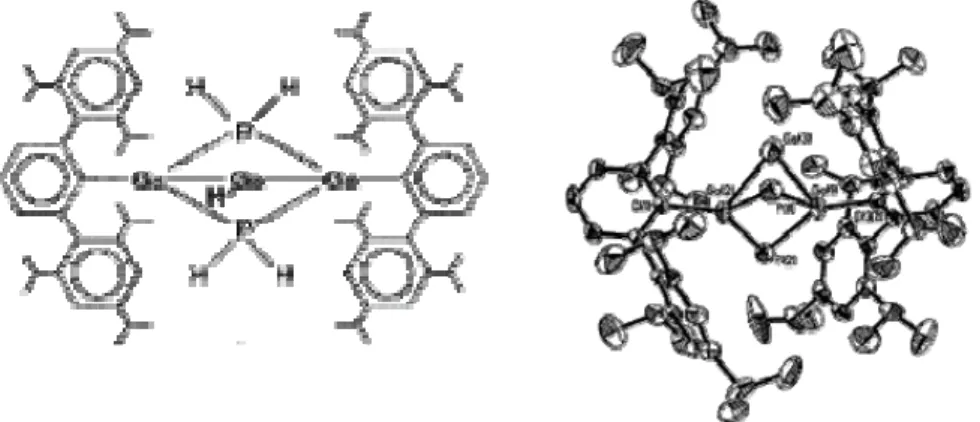
![Figure 1.11: Na 2 [(Me 3 C 6 H 2 ) 2 C 6 H 3 Ga].](https://thumb-eu.123doks.com/thumbv2/123dokorg/2874546.9689/17.892.209.678.393.706/figure-na-me-c-h-c-h-ga.webp)
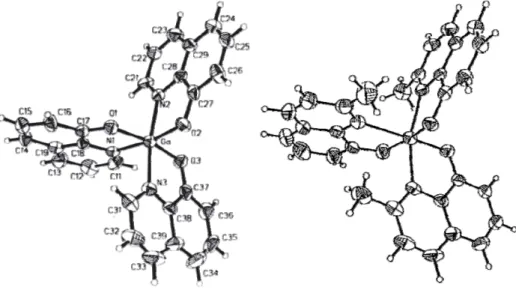
![Figure 1.18: Molecular structure of GaCI[PhC(S)CHC(O)Ph] 2](https://thumb-eu.123doks.com/thumbv2/123dokorg/2874546.9689/25.892.293.594.418.597/figure-molecular-structure-of-gaci-phc-chc-ph.webp)
